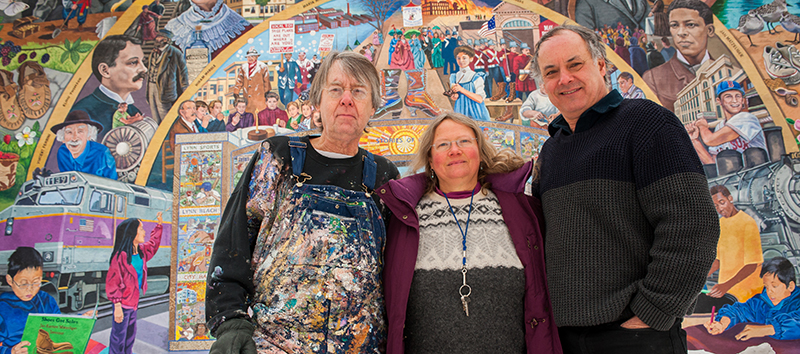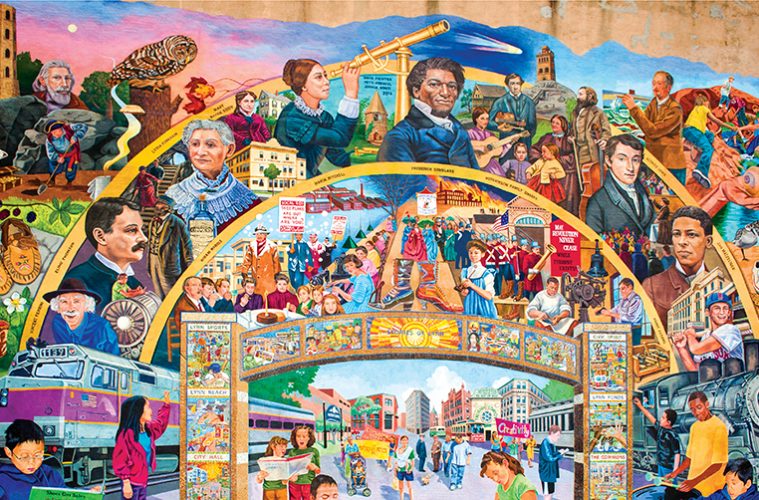Lynn’s pain and its glory are depicted in a new mural on the LynnArts Building in Central Square, the hub of this blue-collar city of 90,000. Three muralists, with input from residents and schoolchildren, have created an eye-popping, historic panorama of the last centuries of this North Shore metropolis. From the General Electric and shoe industries of the 19th century to labor unrest and burning factories to a celebration of Lynn’s abundant natural resources and its pioneering men, women, and children—it’s all there.
On the 60-foot by 60-foot exterior wall at 25 Exchange Street, a stone’s throw from the commuter train stop and the Lynn Museum, passersby can learn all about Lynn’s history. They will see Hiram Marble in his futile quest digging for buried treasure in Lynn Woods’ Dungeon Rock. Astronomer Maria Mitchell is depicted looking through a telescope as she spots the comet that ultimately bore her name. Poet Vincent Ferrini stands dapper in his mustache and signature hat. There are diverse faces of children at study and play who seem to beckon viewers to enter the mural through a 3-D mosaic gateway of their own making. Every brush stroke symbolizes the life that was and the promise that is the city of Lynn.
“It was a long process,” says artist David Fichter of the undertaking. “Seven years ago LynnArts applied for a grant to plan the project and select artists. LynnArts director Susan Halter got a grant from the New England Foundation for the Arts (NEFA). NEFA carried the project with three or four different grants and supported it all the way through.”
After a national search, the team of Fichter, Yetti Frenkel, and Joshua Winer were chosen. They listened to what residents wanted and combined these ideas with their own. The mural would show today’s youth in the foreground, and above would be images of Lynn’s history and prominent creative figures.
Funding from the Massachusetts Cultural Council’s STARS grants enabled the artists to do “residencies” in all six of Lynn’s middle and high schools, where they taught students the art of mosaics.
“We would go to a school and ask the students what was important in their lives,” says Yetti Frenkel. “They said the ethnic foods they eat, playing sports, and being with friends. Kids made drawings and we put those into the design with a little reinterpretation. Once a panel was completed, we would temporarily install it in that school for six months to a year,” says Frenkel. “When we had the panels from all six schools, we installed them at the site.”
The result is the mosaic gateway in the mural’s lower portion. Depicted on the panels are City Hall, Lynn Beach, city ponds, and the Common. In its center is a pair of handsome 14-foot-tall boots, a symbol of the city’s famed shoe industry.
This phase took from 2007 until 2010 to complete. Unfortunately, Halter left LynnArts during this time, signaling the start of funding difficulties. “It didn’t look like anything was going to happen,” recalls Fichter. “So we applied for the grant ourselves through NEFA with the Lynn Museum as our institutional administrator.” But it wasn’t enough money to complete the wall. The artists wondered if they should abandon the project. “But we decided to get it finished,” says Fichter.
They redesigned it, reducing or removing some elements. “We persevered,” notes Fichter. “We are proud that we were able to finish it despite the roadblocks.” Toward the end, Emily Ruddock, director of the Downtown Lynn Cultural District, stepped in, giving the artists the support they needed.
“Public arts projects, especially ambitious ones, take time,” says Ruddock. She says the mural project “fell victim to priority changes” dur- ing a merger of LynnArts and the Lynn Museum. “The board of LynnArts wanted to see it complet- ed. The extra work by the artists to go out and get funds speaks to their professionalism. I came along to help them finish strong.”
The artists concentrated on finishing the upper portion this past fall. They rented a scissor lift to hoist them 60 feet in the air. Shar- ing a narrow 3-foot by 10-foot space for 10-hour days, working even after the autumn sun had sunk be- low the urban landscape, the three muralists plied their trade.
There are images of Lynn’s labor and immigrant past; a family sits around a table celebrating their first year in America; General Electric workers march with placards; and Lynn’s signature three-deckers rise above it all. Also depicted are women marching for fair wages in the late 1800s, a marching band supporting them. An aproned man works on a shoe—Joshua Winer says the man was likely in his “10-footer” shed where cottage-industry shoemaking flourished in the early 1800s. To the shoemaker’s right are a lasting machine and its maker, Jan Matzeliger, whose invention sped up the shoemaking process, thereby lowering costs and changing the industry forever.
When choosing the large portraits, “We were interested in people who had a creative spark,” says Fichter. On the far left of the “people’s arch” are poet Vincent Ferrini, inventor Elihu Thomson, spiritualist Hiram Marble, Lydia Pinkhaman— an entrepreneur who concocted women’s remedies—Christian Science founder Mary Baker Eddy, and astronomer Maria Mitchell. In the center is Frederick Douglass, a reformer, orator, writer, and abolitionist. To the right are the Hutchinson Singers, who sang for the freedom of slaves. Alonzo Lewis wrote the history of Lynn in 1829, and Harry Agganis, “The Golden Greek,” was a football and Red Sox hero.
Outside the people’s arch is the artists’ nod to Lynn’s natural history. Moccasins depict the early days of the Native Americans. Pirate Thomas Veal digs for treasure in the mid-1600s. Behind him stands naturalist and poet Cyrus Tracy, and on the left is painter Charles Woodbury. Children scamper across Red Rock, and sandpipers and sneakers represent common Lynn sights.
The creators of the towering, hand-painted Central Square mural, which was seven years in the making, utilized 500-year-old techniques from start to finish. To be sure, many passersby will ponder its complexity over the next quarter century, as it stands up to time. ?
THE ARTISTS
 |
David Fichter of Cambridge has created 200 murals and mosaics in the United States and abroad. Educated at the Putney School of Vermont and Harvard College, Fichter also creates puppets and set designs for the Underground Railway Theater of Cambridge.
Yetti Frenkel has created a dozen murals on the North Shore and in Greater Boston. She gives poetry and mural workshops, does residencies, has written and illustrated children’s books, and continues to create mosaics, sculptures, and paintings. A Montserrat College of Art graduate, she holds a fine arts degree from the Museum School of Fine Arts in Boston.
Joshua Winer of Waltham has created 150 murals in the United States and abroad. He holds degrees in fresco painting from the Skowhegan School of Painting and Sculpture, a bachelor’s degree in fine arts from Yale University, and a master’s in architecture from Harvard University.

